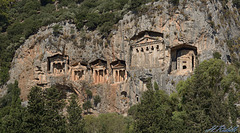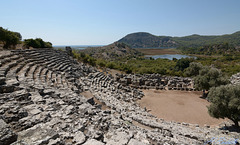
Historic ruins
Dunottar Castle
| |
|
|
|
A rather dramatic view of this splendid castle upon almost an Island just south of Aberdeen, Scotland. It was possible to visit inside too but I had to resist that temptation.
Dunnottar Castle is a ruined medieval fortress located upon a rocky headland on the northeastern coast of Scotland, about 2 miles south of Stonehaven. The surviving buildings are largely of the 15th and 16th centuries, but the site is believed to have been fortified in the Early Middle Ages.
More Info
As always best viewed full screen.
Dunottar Castle view
| |
|
|
|
A bit of good weather brings me back to this castle for a blue-sky traditional shot.
Dunnottar Castle is a ruined medieval fortress located upon a rocky headland on the northeastern coast of Scotland, about 2 miles south of Stonehaven. The surviving buildings are largely of the 15th and 16th centuries, but the site is believed to have been fortified in the Early Middle Ages.
Follow PiP for more info
Enjoy large.
The lost village of Hallsands
| |
|
|
|
The old road to the village: now forbidden!
On a stormy night in January 1917, the Devon fishing village of Hallsands collapsed into the sea. The entire village was destroyed together with the livelihoods of its people. For decades the fishing village of Hallsands and its stunning coastline had been at the mercy of the forces of nature and on this dreadful night, all was finished.
Notice Start Point lighthouse in the distance.
www.bbc.co.uk/insideout/southwest/series1/hallsands.shtml
A glimpse of Corfu
| |
|
|
|
A stunning Island, this taken just as the day was setting, showing Corfu Town itself with both the old and new fortresses.
Taken from the top of our cruise ship: The Marella Discovery.
PiP's
Enjoy full screen
The ancient ruined rock tombs of Kaunos
| |
|
|
|
A wonderful scene meets our eyes, on this boat trip as we round the corner.
These ancient ruined rock tombs of Kaunos near Dalyan date back to the 10th C BC.
Taken from the river Daylan Bogazi some 30 miles east of Marmaris, Turkey.
See PiPs. Best full screen
more info
Kaunos and its Theatre
| |
|
|
|
The theater of the ancient city of Kaunos, dated circa 2nd century BCE. Its capacity was 5000 people. A large wall supported one side of the theater, while the other half was built into the hillside. An innovative periaktos, a device that allows for revolving and rapid change of scenes (sets), also existed at this theater – perhaps the oldest one of its kind. In the distance you can see the Dalyan Delta.
more info
Visions of Kaunos
| |
|
|
|
Although most of this ancient city no longer stands, we see here one of the few structures that does. It is hard to believe that this place was flourishing 2500 years ago. It was totally abandoned around 1500 and lay forgotten for 500 years. Enjoy the ancient arches and windows, through which you can also see the modern town.
The windmills of Rhodes
| |
|
|
|
Also known as 'The Windmills of Mandraki'. That is because, just to the left is the ancient harbour of Mandraki where at its entrance, once stood the 'Colossus of Rhodes', one of the old Wonders of the World. These old mills once ground the grain that entered here from the myriad of merchant ships. ~ Quite a different view from the floodlit night-time one. See pips.
We also see in the background one of the Rhodes lighthouses.
Good full size.
“Unlock”
| |
|
|
|
Seen by the Leeds-Liverpool canal at Pennington Flash.
Thompson Dagnall Sculptor: "Unlocked is a book holding the secrets and stories of the canals.
I aim to use the physical presence of the lock gates to stimulate each traveller’s memories of the canals and hint at the vast library of tales yet to be unearthed.
The sculpture will dominate the viewer and give a taste of the feeling of entering a lock.
The aim of this sculpture is to capture the essence of the canals in an up close and personal way."
www.sculpturecarving.com/unlock
PiPs
Urquhart Castle moods
| |
|
|
|
A lonely sentinel on this equally lonely Loch Ness. Urquhart Castle here displaying its most important tower. For me the light around it gives it an eerie look. See accompanying PiPs for other views.
Urquhart Castle
| |
|
|
|
Enjoy with me this most impressive ruin. Seen from the waves of Loch Ness itself. Fortunately a few moments of sun created a nice spotlight here.
"Once one of Scotland’s largest castles, Urquhart saw great conflict during its 500 years as a medieval fortress. Control of the castle passed back and forth between the Scots and English during the Wars of Independence. The power struggles continued, as the Lords of the Isles regularly raided both castle and glen up until the 1500s.
The last of the government troops garrisoned here during the Jacobite Risings blew up the castle when they left. Urquhart’s iconic ruins remain, offering glimpses into medieval times and the lives of its noble residents." - www.historicenvironment.scot/visit-a-place/places/urquhart-castle
The Pip shows a view from a little further away before we did this closer sail past.
Well worth full size.
Visions of Park Bridge: Ye olde pump house.
| |
|
|
|
This little corner was part of the coal colliery that was sited here. It will have certainly have housed a steam engine as running from here and still present is a small water-way that leads to the weir. Later in its life it was also used in conjunction with the nearby iron works. To me, it has always been a ruin, that should not be a surprise as the cessation of coal mining here was in 1887.
Nice full screen.
Memories of Tuscany: Hilltop Ruin
| |
|
|
|
A winding ploughed field track takes our eye and imagination directly to this ruin. What was it? - I have no idea, but it must have been a fair size with its many windows and high walls. Perhaps a castle of old, belonging to a Baron or Prince before being besieged?
This taken some miles Southwest of Volterra on our way back to Cecina.
Enjoy full screen
Whitby Abbey pointer
| |
|
|
|
A different view to normal of this famous Abbey. At the side of the Abbey stands the old Whitby Hall or as it is also known 'Cholmley House and the Banqueting House' with its replica statue of Borghese's Gladiator which we see here. Part of the Hall is now the Whitby YHA (Youth Hostel Association).
www.yha.org.uk/hostel/yha-whitby
Nice full screen
PiP for adjacent page photo
Whitby Abbey
| |
|
|
|
Whitby Abbey as seen from the side. The sea is just behind me, below the cliffs.
"Whitby Abbey was a 7th-century Christian monastery that later became a Benedictine abbey. The abbey church was situated overlooking the North Sea on the East Cliff above Whitby in North Yorkshire, a centre of the medieval Northumbrian kingdom. The abbey and its possessions were confiscated by the crown under Henry VIII during the Dissolution of the Monasteries between 1536 and 1545.
Since that time, the ruins of the abbey have continued to be used by sailors as a landmark at the headland. Since the 20th century, the substantial ruins of the church have been declared a Grade I Listed building and are in the care of English Heritage; the site museum is housed in Cholmley House just to the right of this picture. (see adjacent photo -PiP)
The abbey is a setting in Bram Stoker’s Dracula (1897). Count Dracula as a creature resembling a large dog which came ashore at the Whitby headland runs up the 199 steps to the graveyard of St Mary's Church in the shadow of the abbey ruins. The abbey is also described in Mina Harker’s diary."
Wiki
Alltan'abrahan grain Mill.
| |
|
|
|
You are now at Alltan'abrahan, just north of Achmelvich, by the old ruined grain mill. There are several old mill stones around the building, which were turned by means of a horizontal paddle. It is hard to imagine in this most inhospitable place that there must have been lots of people walking here with sacks of wheat over their shoulders to have their grain milled.
In the early 18 hundreds, John McCloud , the mill owner, only wanted the hardest grinding stones he could get for his mill, so he found the granite stone he wanted on the slopes of Suilven (see Pip). From there he transported the cut blocks to the little harbour of Loch Inver where he shaped them into these wheels, then he transported the finished products by row-boat to this small valley some five miles (8km) north. See PiPs
Enjoy full size.
Lligwy Burial Chamber
| |
|
|
|
Seen almost at the end of our round coastal walk near Moelfre in North Anglesey. There was in fact an ancient settlement near here too. See PiP.
Lligwy, dating from late Neolithic (New Stone Age) times, would have originally been covered by an earthen mound. When the tomb was excavated in 1908, the bones of men, women and children were found along with animal bones, shells, flint implements, pottery and a bone pin. It has a squashed look about it, as if its supporting stones are being slowly forced into the ground by its massive capstone. That’s not the case, even though this large tomb is roofed by a formidable stone 18ft/5.5m long by 15ft/4.6m wide weighing an estimated 25 tons, one of the biggest in Britain.
The PiP shows one of the dwellings from the Din Lligwy (settlement) that was a lightly fortified settlement, dating from the 3rd-4th century AD, probably inhabited by the Romano-British tribe. Despite the finds mainly from the Roman period, the beginnings of settlement in this area could go back to the Iron Age.
Clachtoll Broch
| |
|
|
|
Clachtoll Broch heavily ruined, the wall stands about 2 metres tall at its highest---it would have been up to 10 metres tall originally. Enough wall still stands at the doorway to show the huge triangular lintel stone above the doorway. This type of lintel stone is a common feature of brochs.
The external diameter is just over 16 metres. The interior has not been excavated and is full of rubble, but is thought to be about 8 metres in diameter.
The usual double-wall construction, with a stairway running up through the cavity, can still be seen.
There are guardchambers on either side of the entrance. A steatite cup was found in a niche in the wall of one of the guard chambers in the early 1900s.
ps this is thought to be in the region of 2000 years old!
Jump to top
RSS feed- Latest items - Subscribe to the latest items added to this album
- ipernity © 2007-2025
- Help & Contact
|
Club news
|
About ipernity
|
History |
ipernity Club & Prices |
Guide of good conduct
Donate | Group guidelines | Privacy policy | Terms of use | Statutes | In memoria -
Facebook
X


















